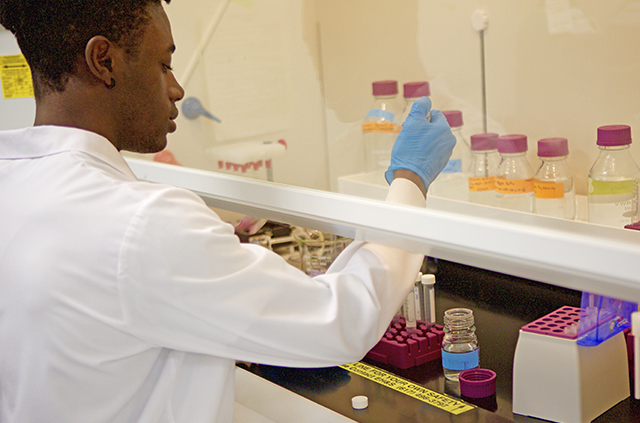Understanding water contamination: the continued role of PFAS
Cecil Myers, S.B. ’21, an environmental science and engineering concentrator at the Harvard A. Paulson School of Engineering and Applied Sciences, is studying how the harmful, yet common chemicals known as PFAS are related to the contamination of drinking water systems.
PFAS, or per- and polyfluoroalkyl substances, denotes a group of man-made chemicals that have been used in a wide variety of industries and applications, from food production to the manufacturing of electronic devices and firefighting foams since the 1940s. These chemicals are extremely persistent in the environment due to the strong bond between carbon and fluorine that does not degrade under natural conditions. Thus they have been accumulating in the environment since the onset of production. A number of studies have shown the adverse effects of PFAS on ecological and human health, including negative impacts on immune health and thyroid function, and increased risk of cardiovascular disease, diabetes, and obesity. Although there has been a series of rollbacks on the manufacturing and usage of two of the most widely produced PFAS in the 1990s (PFOS and PFOA), these chemicals remain in use internationally and new PFAS with unknown health impacts are replacing them, creating the problem known as “chemical whack-a-mole,” according to the U.S. Environmental Protection Agency (EPA).
“I’m doing research on the transport of PFAS in groundwater, how they adsorb to the sediment and influence the flow of groundwater into drinking water systems, which is one of its largest impacts,” said Myers.
Working in the lab of Elsie Sunderland, Gordon McKay Professor of Environmental Chemistry, Myers and his colleagues are focusing on the issue of how PFAS are transported away from contaminated sites and their propensity to affect local drinking water supplies. PFAS do not breakdown easily, so they remain in the soil and water near manufacturing and fire training facilities that use or have used these chemicals for decades, explained Myers. They are transported in groundwater to surrounding water sources, allowing for further contamination of food and drinking water.
Myers, who has been interested in environmental activism since high school, had the opportunity to expand his interest in environmental science and engineering by taking Sunderland’s introductory class during his freshman year.
“I am interested in aquatic ecosystems and the contamination there, so linking up with the Sunderland Lab doing PFAS work in groundwater was perfect,” he said.

Even though some days in the lab can seem long, Myers has thoroughly enjoyed conducting research and the feeling of accomplishment it brings.
“The research aspect itself is actually enjoyable and relatively relaxing,” he said. “It is really rewarding that after all this work you put in, you get to see new data points added to this chart we are making.”
He hopes to continue this research during the fall semester as the lab transitions its focus from PFAS compounds to aqueous film forming foams (AFFF). Myers also wants to use this experience in his future career.
“I have been thinking of doing environmental consulting to help with environmental remediation projects,” he said. “It is interesting because some of the in situ chemical oxidation processes that they do to remediate areas contaminated with oil use solutions that contain PFAS.”
